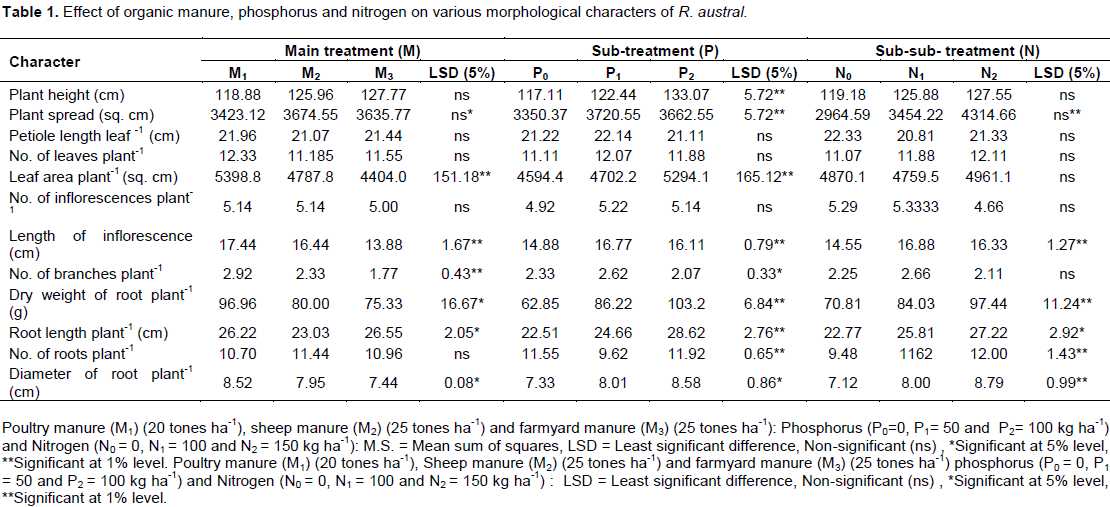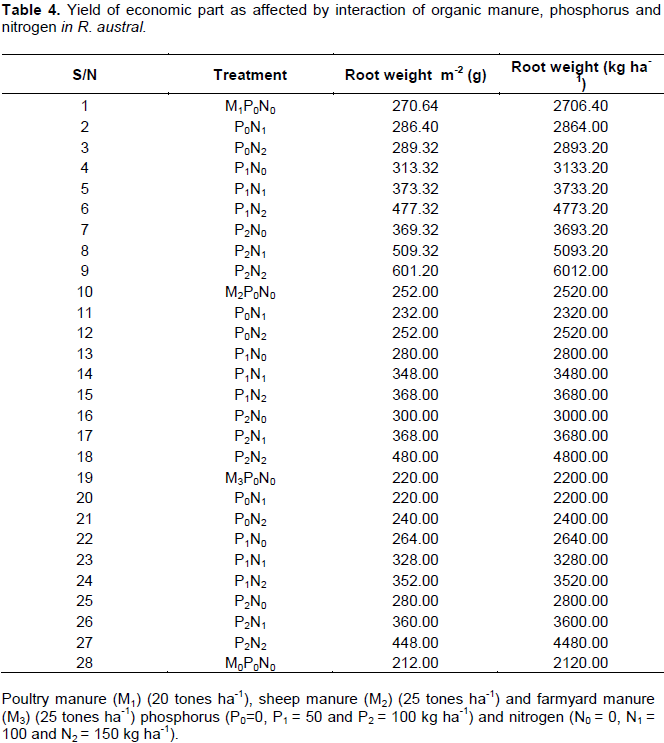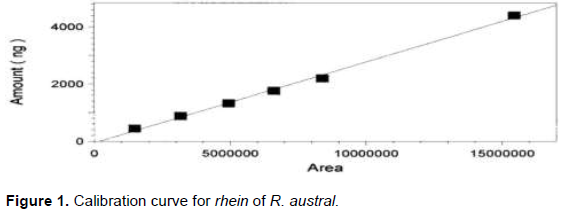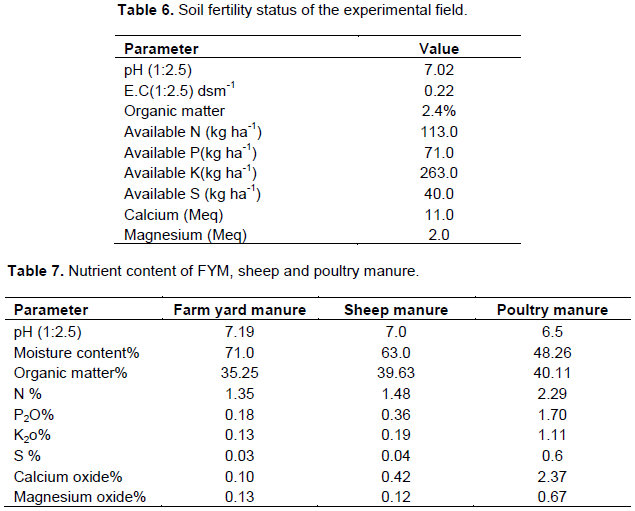Most of the medicinal plant species are collected ruthlessly from the wild source and have become threatened/endangered, thus necessitating the need for their efficient conservation strategies which includes standardization of cultivation practices as the most economical one. The cultivation practices of few medicinal plants of Kashmir Himalayas have been standardized (Kaul, 1983), but same for majority of the rare/threatened medicinal plant species are yet to be standardized. International Union for Conservation of Nature (IUCN) committee for threatened plant species indicates that one in ten species of vascular plants on the earth is endangered or threatened due to commercial exploitation and international trade which may lead to gene erosion in the next 20 to 30 years. Rheum emodi is unfortunately among the top of that list. Therefore, it has been identified as a top priority species for conservation and cultivation (Parveen and Wani, 2013). Indiscriminate and non-systematic collection of this valuable medicinal plant species by pharmaceutical companies for its active constituents and by ethnic people for domestic and traditional herbal mixtures has put severe pressure on the availability of this medicinal plant species (Prasad et al., 2001).
Rheum australe D. Don (syn. Rheum emodi Wall. ex Meissn., Polygonaceae) is a robust, perennial herb with stout rhizomes. The plant species is distributed in the higher regions of Himalaya, covering the areas of India (Kashmir and Sikkim), Bhutan, Nepal, Pakistan, Myanmar, and China (Bao and Alisa, 2003). The roots of R. australe are widely used in Ayurvedic and Chinese folk medicine. This plant species produce diverse phenolic metabolites. More than 56 compounds, belonging to anthraquinones, stilbenes, anthrones, oxanthrone ethers and esters, chromones, flavonoids, carbohydrates, lignans, phenols, and sterols have been identified or characterized from the roots and rhizomes of this plant (Bao and Alisa, 2003, Rokaya et al., 2012, Zargar et al., 2011). Weiguo et al. (2004), determined aloe-emodin, rhein, emodin and chrysophanol content in R. tanguticum [R. palmatum] from Qinghai, China using HPLC method and observed that the emodin, chrysophanol, rhein and aloe-emodin content in R. tanguticum were higher compared to the commercial medicinal materials. Wuche et al. (2000) used capillary electrophoresis (CE) and HPLC methods for the separation of 12 anthraquinones in crude rhei rhizoma (Rheum). Some of these compounds demonstrated a wide range of biological and pharmacological properties. They are used as anti-cholesterolemic, antiseptic, antispasmodic, antitumor, aperient, astringent, cholagogue, demulcent, diuretic, laxative, purgative, neuron protective, stomachic and tonic (Chopra et al., 1986; Xiang et al., 2005). The root is taken internally in the treatment of chronic constipation, liver and gall bladder complaints, haemorrhoids, menstrual problems and skin eruptions due to an accumulation of toxins and externally the root is used in the treatment of burns (Bown, 1995). The active component rhein of the species possesses anticarcinomic, antiseptic, antitumor, antiviral, bactericide, candidicide, cathartic, cytotoxic, pesticide, proteinase-inhibitor, purgative, and viricide properties {(http://www.ansci.cornell.edu/plants/medicinal/rhub.html) (You et al., 2013; Gupta et al., 2014; Andersen et al.,1991). In addition to the curative properties roots of the mentioned species also yield red dye used for coloration of silk and wool (Debaish and Bhattacharya, 2008). Therefore, this plant over the past several decades has been extensively exploited through extraction of crude drug and also through impact of various anthropogenic pressures like grazing, uncontrolled deforestation, selective extraction, and rapid urbanization. The species is categorized as endangered (Nautiyal et al., 2003). In view of the wide application in traditional medicine and in various pharmaceutical industries, it is essential that cultivation practices of the species be initiated, so as to regenerate the germplasm for industrial utilization and to reverse the trend of its extinction in the natural habitat. Further, little is known on the effect of fertilizer application on the root growth and production of bioactive compounds in R. australe roots. Keeping all this in view, the present study of cultivation practices of the species were carried out at lower altitude using different types of organic manures and inorganic fertilisers in order to investigate their effect on the root weight and the amount of active component rhein.
The experiment was carried out at the Experimental Field of Division of Floriculture, landscape and Architecture, Sher-e-Kashmir University of Agricultural Sciences and Technology Kashmir, Shalimar, Jammu and Kashmir, India. The Soil fertility test of the experimental field was done before the planting of the crop (Table 6). The soil of the experimental field was of clay-loam type. The crop was planted in split-split plot design with three replications each on an area of 400 m2 which includes main and sub irrigation channels and path in between beds. Organic manures viz. poultry manure (M1, 20 tones ha-1), sheep manure (M2, 25 tones ha-1) and farmyard manure (M3, 52 tones ha-1) were used as the main factors. Nutrient content of each of the manure used was also determined (Table 7). Three levels each of phosphorus (P0 = 0, P1 = 50 and P2 = 100 kg ha-1) and nitrogen (N0 = 0, N1 = 100 and N2 = 150 kg ha-1) were used as sub and sub-sub factors, respectively. Potassium was applied with a constant level of 50 kg ha-1. One year old seedlings were planted at a spacing of 50 cm × 50 cm in a plot size of 1 m × 1 m. One year old seedlings were planted on 5th of April. Half of the recommended dose of urea (nitrogen source) and the whole dose of diammonium phosphate (phosphorus and nitrogen source) and murat-of-potash (potassium source) were applied at the time of planting. Out of remaining dose of nitrogen, one-fourth dose was applied (in the form of urea) at the time of the first hoeing {(30 days after transplanting (DAT)} and the remaining one-fourth was applied at the time of the 2nd hoeing (64 DAT). Standard package and practices were adopted for raising the healthy crop. Various pre-harvest {(plant height (cm), plant spread (sq. cm), petiole length (cm), number of leaves, leaf area (squared centimeter), number of inflorescences plant-1, length of the inflorescence (cm) and number of branches/shoots plant-1} and post-harvest {root length plant-1 (cm), number of roots plant-1, diameter of root plant-1 (cm) and root weight (dry weight of the root) plant-1} observations were recorded.
Chemoprofiling of some of the samples R. australe using high performance liquid chromatographymethod
Experimental chemicals
Chemoprofiling of the samples was done at Indian Institute of Integrative Medicine, Jammu, Jammu and Kashmir, India. All the chemicals, including solvents were of HPLC grade (Sigma, Aldrich, Germany). The standard for rhein was purchased from Sigma Aldrich, Germany.
Plant material
The rhizomes samples were collected, washed thoroughly with running tap water to remove extraneous material and were air dried at room temperature (18 ±2.5°C).The voucher specimen (voucher no. HKH. 001 to HKH 0013 \HKH/Srinagar) were deposited in the repository of the Division of Floriculture, landscape and Architecture, S.K. University of Agricultural Sciences and Technology, Shalimar, Srinagar, J& K. A Shimadzu HPLC system was used to estimate the concentration of active component. The samples were analyzed at 30°C on a Merck C18 column (5 mm, 250 × 4.0 mm I.D.) by PDA detection.
Preparation of sample solution
Coarse powdered plant material (8.5 mg) was extracted with methanol in Soxhlet while refluxing for 6 to 8 h. The extracts were clarified by centrifugation and then concentrated to dryness under reduced pressure.
Preparation of standard solution
(i) One standard, that is, Rhein, prepared indigenously at RRL Jammu and was dissolved in HPLC grade methanol (1 to 2 mg/10 ml). Equal volume of the solution of the standard was mixed and injected in the HPLC system in volumes 2, 4, 6. 8, 10 and 20 µl for development of standard curve.
(ii) The desiccator dried extract was dissolved in HPLC grade methyl alcohol (12.5 mg/ml) and injected in the HPLC (2, 5 and 10 µl) in order to quantify the extract on the basis of Rhein for which standard curve have already developed. The components were detected at 290 nm using Diode array PDA detector by simultaneous run-off standard compared with its retention time at a flow rate of 1.08 ml min-1 and quantified by standard peak area method.
A Shimadzu HPLC system was used for data analysis and data processing. The samples were analyzed at 30°C on a Merck C18 column (5 mm, 250 × 4.0 mm I.D.) by PDA detection.
Calculation of results
Active component in each crop (in percent) was estimated by using the formula:
Statistical analysis
The data on various observations collected was subjected to statistical analysis of variance as detailed by Cochran and Cox (1960) for split-split plot design. The significance of the treatment effects was estimated with the help of F-test at 5 and 1% level of significance.
Effect of organic manure on various yield determining characters of R. australe
The effect of organic manure on plant spread, leaf area, length of inflorescence, number of branches, root weight, root length and diameter of root was either significant or highly significant. Maximum plant spread (3674.55 cm2 plant-1) was observed in treatment M2 and minimum (3423.14 cm2) in treatment M1 (Table 1). Treatments M2 and M3 were at par with each other but were statistically different from treatment M1. With respect to leaf area, length of inflorescence and number of branches all the treatments M1, M2 and M3 were statistically different from each other (Table 1). Jahan et al. (2004) also showed that consuming 30 ton/ha manure can increase sub- branches of chamomile (Matricaria chamomilla L). With respect to length of roots, it was influenced significantly (p<0.01) by the application of organic manure (Table 1). Treatments M1 and M3 were at par with each other, but were statistically different from treatment M2. The diameter of the root ranged from 7.44 to 8.52 cm. Treatments varied significantly for this trait, though treatments M1 and M2 were at par with each other (Table 1). This is because organic matter uptake can increase soil nutrition content and its absorbing capacity and at the same time, it enhances nitrogen equilibrium and phosphorous absorption efficiency. However, the effect was non-significant for plant height, petiole length, number of leaves, inflorescences and number of roots.

Effect of organic manure on root weight of R. australe
The organic manure comprised of three different manures viz. poultry, sheep and farm yard manure. Data recorded on dry weight of root plant-1 recorded that organic manure had a significant effect on dry weight of roots plant-1 (Table 1). Treatment M1 was statistically different from treatment M2 and M3. Highest dry weight (96.96 g) of root plant-1 was recorded in treatment M1 and the least (75.33 g) in treatment M3 (Table 1). The difference in dry weight of root plant-1 between M1 and M3 treatments was 21.63 g and between M1 and M2 treatments it was only 16.96 g, obviously; indicating that poultry manure yields better results as compared to sheep and farm yard manure. On per hectare basis (kg ha-1) the dry root weight recorded by the application of poultry, sheep and farm yard manure was of the order of 3878.40, 3200.0 and 3010.0 kg ha-1, respectively. Application of poultry manure produced 678.40 and 868.40 kg ha-1 more yield over
the sheep and farm yard manure (Table 3). The increase in root yield was the cumulative effect of the yield attributes. The high response of R. australe in terms of root yield may be attributed to additional nutrition supplied through poultry manure. However, Nautiyal et al. (2003) reported more yield in forest litter treated beds as compared to buffalo and sheep manure treated beds in R. emodi.

Effect of phosphorus on various yield determining characters of R. australe
Phosphorus had a significant (p <0.05) or highly significant (p < 0.01) effect on plant height, plant spread, leaf area, length of inflorescences, root length, number of roots, number of branches and diameter of root. All the treatments were statistically different from each other. Higher plant height (133.07 cm) was obtained in treatment P2 as compared to other two treatments (P0 and P2). Phosphorus resulted in a concomitant increase in the leaf area plant-1. Maximum leaf area (5294.1 cm2) was recorded in treatment P2 and minimum (4594.4 cm2) in treatment P0. Treatment P2 was statistically different from P1 and P0. Increase in length of inflorescence, diameter of root, root length, number of roots and number of branches was also observed with increasing levels of phosphorus. However, different levels of phosphorus did not differ significantly with respect to each other in petiole length, number of leaves and number of inflorescences (Table 1).
Effect of phosphorus on root weight of R. australe
Application of phosphorus had a highly significant (p<0.01) effect on the root weight (Table 1). All the treatments P0, P1 and P2 were statistically different from each other. The highest dry weight of root (103.20 g plant-1) was observed in treatment P2 and the least (62.85 g plant-1) in control (P0). On per hectare basis the dry weight of root increased significantly from 934.80 to 1614.00 kg ha-1 with increasing levels of phosphorus (50 to 100 kg ha-1) (Table 3). Increase in root yield seems to be a reflection of favourable influence of phosphorus on important yield attributes like plant height, plant spread, leaf area, root length and root diameter. Proper nutrition of plants is an important factor in determining their performance. Phosphorus being a macronutrient plays a vital role in plant growth and development. Thus higher phosphorus levels seem to have helped in increasing the crop growth by the improvement of yield attributes. Similar results were obtained by Lu et al. (2013) while working with Salvia miltiorrhiza. In a similar way, Ombodi and Saigusa (2000) reported that fertilizer treatments improve the nutritional quality of rhubarb. They also reported that the improved nutritional quality in the polyofelin-coated diammonium phosphate (POC-DAP) treatment was a cause of ammonium nutrition rather than a cause of less amount of released nitrogen.
Effect of nitrogen on various yield determining characters of R. australe
The effect of nitrogen on plant height, petiole length, no. of branches, no. of leaves, leaf area and no. of inflorescences plant-1 was non-significant. However, the highest plant height and numbers of leaves plant-1 was obtained in treatment N2 and the least in control (N0). Increase in the value of various morphological characters with the application of nitrogen fertilizers was also reported by Ozguven and Sekeroglu (2007) while working with black cumin. Plants depicted a significant increase (p < 0.01) in plant spread, root length, number of roots and diameter of root with the increase in nitrogen application. Maximum plant spread (4314.66 cm2 plant-1) was observed in treatment N2 and minimum (2964.59 cm2 plant-1) in control (N0). In case of root length and no. of roots plant-1 treatments N2 and N1 were statistically
different from treatment N0. Highest diameter of root (8.79 cm plant-1) was observed in treatment N2 and the least (7.12 cm plant-1) in control treatment (N0). Treatment N2 was statistically different from treatments N1 and N0. However, treatment N1 was at par with a control (N0) (Table 1). El-Sayed et al. (2012) also found that the highest level of nitrogen (300 kg/fed.) on Echinacea parudoxa L. significantly improved plant height, fresh and dry weight of herb, fresh and dry weight of whole plant.
Effect of nitrogen on root weight of R. australe
Root weight depicted a linear increase with increasing levels of nitrogen. It had a highly significant influence (P<0.01) on dry weight of root plant-1 (Table 1). All the treatments viz. N0, N1 and N2 were statistically different from each other. Highest root weight of 97.44 g plant-1 was observed in treatment N2 and the least of 70.81 g in treatment N0 (Table 1). On per hectare bases, the highest (3897.60 kg ha-1) dry weight of root was observed in treatment N2 and least (2832.40 kg ha-1) in treatment N0 (Table 3). The results obtained agreed with Shaheen et al. (2007) who showed that, treating Cynara scolymus with 100 to 120 kg N/fed as ammonium sulphate gained the best values of fresh and dry weight yield. Increase in the yield is attributable to the vigorous growth of plants with respect to plant height, plant spread and other morphological features at higher level of nitrogen (150 kg ha-1) (Table 1); resulting in accumulation of more photosynthates, which are responsible for increasing root yield. Nitrogen being a major constituent of proteins and phospholipids plays a vital role in plant growth and development. Thus higher nitrogen levels have helped in increasing the crop growth and improvement of yield attributes. Similar findings were reported by Rishi et al. (1988) in Dioscorea deltoidea, where they found that the tuber yield ha-1 and diosgenin content increased with the application of nitrogen up to 80 kg ha-1. Even the nutritional quality of rhubarb has been reported to improve as a result of nitrogen fertilization (Ombodi and Saigusa, 2000).
Effect of interaction of organic manure, phosphorus and nitrogen on various yield determining characters of R. austral
The effect of interaction was significant (p<0.005) or highly significant (p<0.001) on plant height, plant spread, petiole length, leaf area and number of branches plant-1 (Table 2). The highest plant height (163.00 cm plant-1) was obtained in treatment M1P2N2 and least (84.00 cm plant-1) in treatment M1P2N0 (Table 2). Treatment M1P2N2 was at par with treatments M2P1N0, M2P2N0, M2P2N1, M2P2N2, M3P0N2, M3P1N1 and M3P2N2 but was statistically different from all other treatments. Remarkably significant (p < 0.001) increase in plant spread plant-1 was observed in all most all the treatments with the application of organic manure, phosphorus and nitrogen (Tables 2). Highest plant spread (5399.00 cm2 plant-1) was observed in the treatment M1P1N2, as compared to the plant spread of 1535.00 cm2 plant-1 in treatment M1P1N0 (Table 2). Leaf area plant-1 increased significantly (p < 0.01) in all the treatments with the application of organic manure, phosphorus and nitrogen (Table 2). The effect of interaction was non-significant on number of leaves, length of inflorescence, root length, number of roots, and diameter of root.
Effect of interaction of organic manure, phosphorus and nitrogen on root yield or root weight (kg ha-1) of R. australe
Maximum dry root weight of 150 g plant-1 was observed in treatment M1P2N2 compared to the lowest dry yield of 53 g plant-1 in control treatment M0P0N0 (Table 2). However, the effect of interaction was non-significant (Table 2). Maximum dry root weight (6012.00 kg ha-1) was observed in treatment M1 P2 N2 compared to the lowest yield (2120.00 kg ha-1) in control treatment M0 P0 N0 (Table 4). Poultry, sheep or farmyard manure in combination with higher levels of nitrogen (150 Kg ha-1) and phosphorus (100 kg ha-1) resulted in increased yield of root. Further, results revealed that poultry manure in combination with higher level of nitrogen and phosphorus showed the highest dry yield of root in contrast to sheep and farm yard manure receiving the same combination of inorganic fertilizers. It was also observed that poultry manure when used in combination with lower or higher levels of phosphorus (50 and 100 kg ha-1) and nitrogen (100, 150 kg ha-1) produced a higher dry yield of root (Table 4). This is in contrast to sheep manure or farmyard manure receiving the same combination of inorganic fertilizers. Evidently, poultry manure had a remarkable effect on the dry weight of the root irrespective of the inorganic fertilizer used as compared to sheep or farmyard manure; even though the quantity of poultry manure applied was less than the sheep and farm yard manure (Table 4). Increase in root yield seems to be a reflection of favourable influence of organic manure and inorganic fertilizers on important yield attributes like plant height, plant spread and leaf area (Table 2).

Chemoprofiling of thirteen different extracts or samples of R. australe on the basis of one marker rhein
Calibration curve
Rhein : Linear Y= 0.000277389x+0
Goodness of fit (rˆ2): 0.996119
The calibration curve and the chromatogram of the standard rhein are given in Figures 1 and 2. Highest amount of rhein content (0.393) was observed in treatment M1P2N2 (20 tones poultry manure ha-1, 100 kg phosphorus ha-1, and 150 kg nitrogen ha-1) and the least (0.153) in control treatment (M0P0N0) (Table 5). Among the manures, the highest rhein content was obtained in treatment M1P0N0 (20 tones poultry manure ha-1, 0 kg phosphorus ha-1, and 0 kg nitrogen ha-1) followed by treatment M2P0N0 and the least in treatment M3P0N0. Poultry, sheep and farm yard manure used in combination with higher levels of phosphorus (100 kg ha-1) and nitrogen (150 kg ha-1) produced slightly increased rhein content (0.394, 0.360 and 0.315%) as compared to other treatment combinations except treatment M1P2N0 (0.315%). Rishi et al. (1988) reported an increase in diosgenin content in Dioscorea deltoidea with the increase in application of nitrogen up to 80 kg ha-1. Plants of these treatments showed an increasing trend in dry weight accumulation also. Highest rhein content was observed when poutry manure was used in combination with P or N. This is in contrast to sheep or farm yard manure in combination with P or N. Treatments with maximum quantity of nitrogen (150 kg ha-1) in combination with organic manure, but no phosphorus viz. treatments M1P0N2, M1P0N2 and M1P0N2 displayed lesser rhein content (0.315, 0.270 and 0.24 6%, respectively). Conversely to respective treatments viz. M1P2N0, M1P2N0 and M1P2N0 with maximum concentration of phosphorus (100 kg ha-1) in combination with organic manure, but no nitrogen, were having maximum content of rhein (0.165, 0.120 and 0.087% respectively). The latter treatments were also with higher root weight in contrast to former treatments. Similar observations, that is, enhancement in the amount of alkaloid content in various medicinal plants by applying different doses of organic manure and inorganic fertilizers have also been made by various workers in Datura sp. (Esendal et al., 2000), Atropa belladonna (Baricevic et al., 2002) and Artemisia sp. (Usha and Swamy, 2002).



The root yield and rhein content of R. australe increased with the application of organic manure, phosphorus and nitrogen. Highest dry yield of root was observed in treatments which received poultry manure in combination with higher level of phosphorus and nitrogen in contrast to sheep and farm yard manure receiving the same combination of inorganic fertilizers. Increased fertilization resulted in increase in various yield determining morphological characters, which ultimately resulted in increased root weight. The large scale exploitation of the species to meet the ever-increasing demand of drug industry is one of the major causes of the extirpation of its population in nature. It is, therefore, imperative and high time to grow the species on a commercial scale not only to cater the requirements of the drug industry but also to save the species from extinction. The method of standardizing the cultivation practices will ensure an everlasting supply of the raw material to the pharma-ceutical industry and will also help in the improvement of crops under plant-breeding programme.
The authors have not declared any conflict of interests.